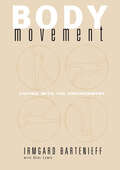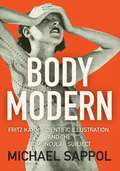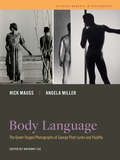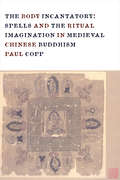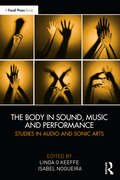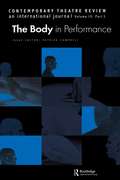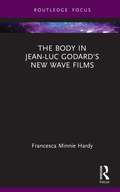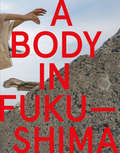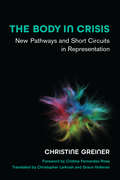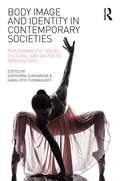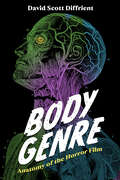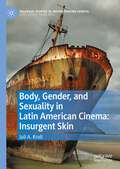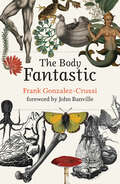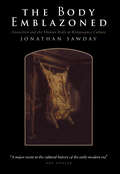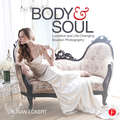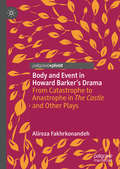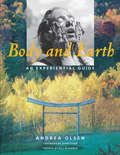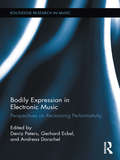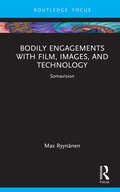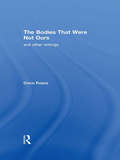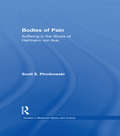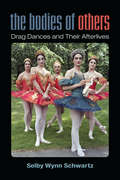- Table View
- List View
Body Movement: Coping with the Environment
by Irmgard Bartenieff Dori Lewis"'Irmgard Bartenieff has a profound knowledge of the human body and how it moves. I am delighted that this will now be made available to many more people.'." -- George Balanchine of Director, New York City Ballet"'Irmgard Bartenieff's pioneering work in the multiple applications of Labananalysis has had a transforming influence on many areas of movement training. Her careful and detailed development of the spatial principles into active corrective work has illuminated and altered the training of people as varied as dancers, choreographers, physical therapists, movement and dance therapists, and psychotherapists. Anthropologists and non-verbal communication researchers have found their world view necessarily altered by her fundamental innovations. The field of body/mind work will need to adapt to include her clear working through of basic principles.'." -- Kayla Kazahn Zalk of President, American Dance Guild
Body Modern: Fritz Kahn, Scientific Illustration, and the Homuncular Subject
by Michael SappolA poster first printed in Germany in 1926 depicts the human body as a factory populated by tiny workers doing industrial tasks. Devised by Fritz Kahn (1888–1968), a German-Jewish physician and popular science writer, “Der Mensch als Industriepalast” (or “Man as Industrial Palace”) achieved international fame and was reprinted, in various languages and versions, all over the world. It was a new kind of image—an illustration that was conceptual and scientific, a visual explanation of how things work—and Kahn built a career of this new genre. In collaboration with a stable of artists (only some of whom were credited), Kahn created thousands of images that were metaphorical, allusive, and self-consciously modern, using an eclectic grab-bag of schools and styles: Dada, Art Deco, photomontage, Art Nouveau, Bauhaus functionalism, and commercial illustration. In Body Modern, Michael Sappol offers the first in-depth critical study of Fritz Kahn and his visual rhetoric. Kahn was an impresario of the modern who catered to readers who were hungry for products and concepts that could help them acquire and perform an overdetermined “modern” identity. He and his artists created playful new visual tropes and genres that used striking metaphors to scientifically explain the “life of Man.” This rich and largely obscure corpus of images was a technology of the self that naturalized the modern and its technologies by situating them inside the human body.The scope of Kahn’s project was vast—entirely new kinds of visual explanation—and so was his influence. Today, his legacy can be seen in textbooks, magazines, posters, public health pamphlets, educational websites, and Hollywood movies. But, Sappol concludes, Kahn’s illustrations also pose profound and unsettling epistemological questions about the construction and performance of the self. Lavishly illustrated with more than 100 images, Body Modern imaginatively explores the relationship between conceptual image, image production, and embodied experience.
Body Language: The Queer Staged Photographs of George Platt Lynes and PaJaMa (Defining Moments in Photography #7)
by Dr. Angela MillerExamines early practices of staged photography in visualizing queer forms of relation. Body Language is the first in-depth study of the extraordinary interplay between George Platt Lynes and PaJaMa (Paul Cadmus, Jared French, and Margaret Hoening French). Nick Mauss and Angela Miller offer timely readings of how their practices of staging, collaboration, and psychological enactment through the body arced across the boundaries of art and life, private and public worlds, anticipating contemporary social media. Using the camera not to capture, but to actively perform, they renounced photography’s conventional role as mirror of the real, energizing forms of world-making via a new social framing of the self.
The Body Incantatory: Spells and the Ritual Imagination in Medieval Chinese Buddhism (The Sheng Yen Series in Chinese Buddhist Studies)
by Paul CoppWhether chanted as devotional prayers, intoned against the dangers of the wilds, or invoked to heal the sick and bring ease to the dead, incantations were pervasive features of Buddhist practice in late medieval China (600–1000 C.E.). Material incantations, in forms such as spell-inscribed amulets and stone pillars, were also central to the spiritual lives of both monks and laypeople. In centering its analysis on the Chinese material culture of these deeply embodied forms of Buddhist ritual, The Body Incantatory reveals histories of practice—and logics of practice—that have until now remained hidden.Paul Copp examines inscribed stones, urns, and other objects unearthed from anonymous tombs; spells carved into pillars near mountain temples; and manuscripts and prints from both tombs and the Dunhuang cache. Focusing on two major Buddhist spells, or dhāraṇī, and their embodiment of the incantatory logics of adornment and unction, he makes breakthrough claims about the significance of Buddhist incantation practice not only in medieval China but also in Central Asia and India. Copp's work vividly captures the diversity of Buddhist practice among medieval monks, ritual healers, and other individuals lost to history, offering a corrective to accounts that have overemphasized elite, canonical materials.
The Body Incantatory: Spells and the Ritual Imagination in Medieval Chinese Buddhism
by Paul CoppIn centering its analysis on the Chinese material culture of deeply embodied forms of Buddhist ritual, The Body Incantatory reveals histories of practice--and logics of practice--that have until now remained hidden
The Body in Sound, Music and Performance: Studies in Audio and Sonic Arts
by Linda O KeeffeThe Body in Sound, Music and Performance brings together cutting-edge contributions from women working on and researching contemporary sound practice. This highly interdisciplinary book features a host of international contributors and places emphasis on developments beyond the western world, including movements growing across Latin America. Within the book, the body is situated as both the site and centre for knowledge making and creative production. Chapters explore how insightful theoretical analysis, new methods, innovative practises, and sometimes within the socio-cultural conditions of racism, sexism and classicism, the body can rise above, reshape and deconstruct understood ideas about performance practices, composition, and listening/sensing. This book will be of interest to both practitioners and researchers in the fields of sonic arts, sound design, music, acoustics and performance.
The Body in Performance
by Patrick CampbellLively yet intriguing, The Body in Performance is a varied collection of essays about this much-discussed area. Posing the question "Why this current preoccupation with the performed body?" the collection of specially commissioned essays from both academics and practitioners - in some cases one and the same person - considers such cutting edge topics as the abject body and performance, censorship and live art, the presentation of violence on stage, carnal art, and the vexed issue of mimesis in the theatre. Drawing variously on the work of Franko B., Orlan, Annie Sprinkle, Karen Finley, and Forced Entertainment, it concludes with a creative piece about a 'Famous New York Performance Artist.' Contributors include Rebecca Schneider whose book The Explicit Body in Performance is a key text in this area, and Joan Lipkin, director and writer.
The Body in Jean-Luc Godard's New Wave Films (Routledge Focus on Film Studies)
by Francesca Minnie HardyThis original study examines the representation of the body in French New Wave films through discussion of a series of films by Jean-Luc Godard, perhaps the central figure of the French New Wave. Through analysis of À bout de souffle, Une femme est une femme, Le Mépris and Alphaville, alongside discussion of some of Godard’s lesser-known French New Wave films, the book explores the interrelation between bodies, books and bathrooms that they facilitate. In so doing, it aims to destabilise the French New Wave’s myth of male exceptionalism and denaturalise the gender dynamic most commonly viewed at its heart, revealing that the women who make up a fundamental part of its fabric are not textually trapped by Godard’s authorial presence. Instead, their corporeality disrupts any purported authorial and national ownership of their bodies. Given the enduring popularity and visibility of the French New Wave, and of Jean-Luc Godard, in universities and journals, The Body in Jean-Luc Godard’s New Wave Films will appeal to scholars in the disciplines of French and film studies, as well as to undergraduate and postgraduate students of these disciplines.
A Body in Fukushima
by Eiko Otake William JohnstonOn March 11, 2011 one of the most powerful earthquakes in recorded history devastated Japan, triggering a massive tsunami and nuclear meltdowns at three reactors in the Fukushima Daiichi Nuclear Power Plant complex in a triple disaster known as 3.11. On five separate journeys, Japanese-born performer and dancer Eiko Otake and historian and photographer William Johnston visited multiple locations across Fukushima, creating 200 transformative color photographs that document the irradiated landscape, accentuated by Eiko's poses depicting both the sorrow and dignity of the land. The book also includes essays and commentary reflecting on art, disaster, and grief.From the PrefaceTHIS IS A BOOK OF FUKUSHIMA. THIS IS A BOOK OF WAILING AND UPSET, inhabiting time after March 11, 2011 and imagining time before then. This is a book of the irradiated landscape of Fukushima. This is a book of violence, and of disasters, fast and slow. This is a book of people, mountains, fields and the sea. This book is A Body in Fukushima: the body of a performer—an immigrant artist from Japan, and the body of a historian who is also a photographer, and the body of the land itself.We traveled together to Fukushima five times between 2014 and 2019. Eiko performed in the disrupted landscapes. Bill photographed the performances. Together we selected the photographs and writings for this book, and Bill wrote the captions. The year 2021 marks the tenth anniversary of the Fukushima nuclear disaster. The Timeline in the book extends to include a deeper history that is part of this tragedy and this place. And Places Visited shows the coastline where we performed and photographed. We hope that these images allow you to enter Fukushima, to feel and smell it. —EO & WJ
The Body in Crisis: New Pathways and Short Circuits in Representation (Studies in Dance: Theories and Practices)
by Christine GreinerThe Body in Crisis introduces the English-speaking world to the work of leading Latin American dance scholar and philosopher of the body, Christine Greiner. The book offers an innovative set of tools with which to examine the role of moving bodies and bodily actions in relation to worldwide concerns, including identity politics, alterity, migration, and belonging. The book places the concept of bodymedium in dialogue with the work of Giorgio Agamben to investigate notions of alterity, and shows how an understanding of the body-environment continuum can shed light on things left unnamed and at the margins. Greiner’s analyses draw from a broad range of theory concerned with the epistemology of the body, including cognitive science, political philosophy, evolutionary biology, and performance studies to illuminate radical experiences that question the limits of the body. Her analysis of the role that bodies play in negotiations of power relations offers an original and unprecedented contribution to the field of dance studies and expands its scope to recognize theoretical models of inquiry developed in the Global South.
Body Image and Identity in Contemporary Societies: Psychoanalytic, social, cultural and aesthetic perspectives
by Ekaterina Sukhanova Hans-Otto ThomashoffPopular interest in body image issues has grown dramatically in recent years, due to an emphasis on individual responsibility and self-determination in contemporary society as well as the seemingly limitless capacities of modern medicine; however body image as a separate field of academic inquiry is still relatively young. The contributors of Body Image and Identity in Contemporary Societies explore the complex social, political and aesthetic interconnections between body image and identity. It is an in-depth study that allows for new perspectives in the analysis of contemporary visual art and literature but also reflects on how these social constructs inform clinical treatment. Sukhanova and Thomashoff bring together contributions from psychoanalysts, psychotherapists, psychiatrists and scholars in the fields of the social sciences and the humanities to explore representations of the body in literature and the arts across different times and cultures. The chapters analyse the social construction of the 'ideal' body in terms of beauty, gender, sexuality, race, ethnicity, class and disability, from a broadly psychoanalytic perspective, and traces the mechanisms which define the role of the physical appearance in the formation of identity and the assumption of social roles. Body Image and Identity in Contemporary Societies' unique interdisciplinary outlook aims to bridge the current gap between clinical observations and research in semiotic theory. It will be of interest to psychoanalysts, psychotherapists, art therapists, art theorists, academics in the humanities and social sciences, and those interested in an interdisciplinary approach to the issues of body image and identity. Ekaterina Sukhanova is University Director of Academic Program Review at the City University of New York USA. She serves as Scientific Secretary of the Section for Art and Psychiatry and the Section of Art and Psychiatry of the World Psychiatric Association. She is also engaged in interdisciplinary research on cultural constructs of mental health and illness and curates exhibits of art brut as a vehicle for fighting stigma. Hans-Otto Thomashoff was born in Germany and lives in Vienna. He is a psychiatrist, psychoanalyst, art historian and author of fiction and non-fiction books. He has been curator of several art exhibitions highlighting the connection between the psyche and art as well as president of the section of Art and Psychiatry of the World Psychiatric Association and advisory committee member of the Sigmund Freud Foundation, Vienna.
Body Genre: Anatomy of the Horror Film (Horror and Monstrosity Studies Series)
by David Scott DiffrientIn this groundbreaking work, author David Scott Diffrient explores largely understudied facets of cinematic horror, from the various odors permeating classic and contemporary films to the wetness, sliminess, and stickiness of these productions, which, he argues, practically scream out for a tactile mode of textural analysis as much as they call for more traditional forms of textual analysis. Dating back to Carol Clover’s and Linda Williams’s pioneering work on horror cinema, film scholars have long conceptualized this once-disreputable category of cultural production as a “body genre.” However, despite the growing recognition that horror serves important biological and social functions in our lives, scholars have only scratched the surface of this genre with regard to its affective, corporeal, and sensorial appeals.Diffrient anatomizes horror films in much the same way that a mad scientist might handle the body, separating and recombining constitutive parts into a new analytical whole. Further, he challenges the tendency of scholars to privilege human over nonhuman beings and calls into question ableist assumptions about the centrality to horror films of sight and sound to the near exclusion of other forms of sense experience. In addition to examining the role that animals—living or dead, real or fake—play in human-centered fictions, this volume asks what it means for audiences to consume motion pictures in which actors, stunt performers, and other creative personnel have put their own bodies and lives at risk for our amusement. Historically grounded and theoretically expansive, Body Genre: Anatomy of the Horror Film moves the study of cinematic horror into previously unchartered waters and breathes life into a subject that, not coincidentally, is intimately connected to breathing as our most cherished dividing line between life and death.
Body, Gender, and Sexuality in Latin American Cinema: Insurgent Skin (Palgrave Studies in (Re)Presenting Gender)
by Juli A. KrollInsurgent Skin: Body, Gender, and Sexuality in Latin American Cinema argues that twenty-first century Latin American cinema about lesbian, feminist, intersex, and transgender themes is revolutionary because it disrupts heteronormative and binary representation and explores new, queer signifying modes.Grounded in feminist and queer theory, Insurgent Skin conjugates film phenomenology and theories of affect and embodiment to analyze a spectrum of Latin American films.The first chapters explore queer signifying in Argentinean director Lucrecia Martel’s Salta trilogy and the lesbian utopia of Albertina Carri’s Las hijas del fuego (2018). Next, the book discusses the female body as uncanny absence in Tatiana Huezo’s documentary Tempestad (2016), a film about gendered violence in Mexico. Chapter Five focuses on intersex films and the establishing of queer solidarity and an intersex gaze. The last chapter examines transgender embodiment in the Chilean film Una mujer fantástica (2017) and Brazilian documentary Bixa Travesty (2018).
The Body Fantastic
by Frank Gonzalez-CrussiThe body in dreams, myths, legends, and anecdotes of the fantastic as expressions of human corporeality.In The Body Fantastic, Frank Gonzalez-Crussi looks at the human body through the lens of dreams, myths, legends, and anecdotes of the bizarre, exploring the close connection of the fictitious and the fabulous to our conception of the body. He chronicles, among other curious cases, the man who ate everything (including boiled hedgehogs and mice on toast), the therapeutic powers of saliva, hair that burst into flames, and an "amphibian man" who lived under water. Drawing on clinical records, popular lore, and art, history, and literature, Gonzalez-Crussi considers the body in both real and imaginary dimensions. Myths and stories, Gonzalez-Crussi reminds us, are the symbolic expression of our aspirations and emotions. These fantastic tales of bodies come from the deepest regions of the human psyche. Ancient Greeks, for example, believed that the uterus wandered around inside a woman's body--an "animal within an animal." If a woman sniffed an unpleasant odor, the uterus would retreat. Organized "digestive excess" began with the eating and drinking contests of antiquity and continue through the hot-dog eating competitions of today. And the "libido-podalic association," connecting male sexuality and the foot, insinuated itself into mainstream medicine in the sixteenth century; meanwhile, the feet of women in some cultures were scrupulously kept from view. Gonzalez-Crussi shows that the many imaginary representations of the body are very much a part of our corporeality.
The Body Emblazoned: Dissection and the Human Body in Renaissance Culture
by Jonathan SawdayAn outstanding piece of scholarship and a fascinating read, The Body Emblazoned is a compelling study of the culture of dissection the English Renaissance, which informed intellectual enquiry in Europe for nearly two hundred years. In this outstanding work, Jonathan Sawday explores the dark, morbid eroticism of the Renaissance anatomy theatre, and relates it to not only the great monuments of Renaissance art, but to the very foundation of the modern idea of knowledge. Though the dazzling displays of the exterior of the body in Renaissance literature and art have long been a subject of enquiry, The Body Emblazoned considers the interior of the body, and what it meant to men and women in early modern culture. A richly interdisciplinary work, The Body Emblazoned re-assesses modern understanding of the literature and culture of the Renaissance and its conceptualization of the body within the domains of the medical and moral, the cultural and political.
Body, Dress, and Identity in Ancient Greece
by Mireille M. LeeThis is the first general monograph on ancient Greek dress in English to be published in more than a century. By applying modern dress theory to the ancient evidence, this book reconstructs the social meanings attached to the dressed body in ancient Greece. Whereas many scholars have focused on individual aspects of ancient Greek dress, from the perspectives of literary, visual, and archaeological sources, this volume synthesizes the diverse evidence and offers fresh insights into this essential aspect of ancient society.
The Body and the City: Psychoanalysis, Space and Subjectivity
by Steve PileOver the last century, psychoanalysis has transformed the ways in which we think about our relationships with others. Psychoanalytic concepts and methods, such as the unconscious and dream analysis, have greatly impacted on social, cultural and political theory. Reinterpreting the ways in which Geography has explored people's mental maps and their deepest feelings about places, The Body and the City outlines a new cartography of the subject. The author maps key coordinates of meaning, identity and power across the sites of body and city. Exploring a wide range of critical thinking, particularly the work of Lefebvre, Freud and Lacan, he analyses the dialectic between the individual and the external world to present a pathbreaking psychoanalysis of space.
Body and Soul: Lucrative and Life-Changing Boudoir Photography
by Susan EckertBody and Soul presents a unique and emotionally intelligent approach to building a sustainable boudoir photography business. The higher-level strategies within these pages will enable photographers to move beyond the task of simply making pretty pictures to greater goals, such as understanding the emotional journey of the boudoir process, building meaningful, long-term relationships with clients, and creating a referral engine to sustain your business. Susan Eckert combines her professional experience as an internationally published photographer with her advanced degree in Psychology to deconstruct the boudoir experience. Each chapter is complemented by interviews with her clients, and illustrates how photographers can partner with their clients throughout the boudoir process in the development of meaningful work. Highlights of this book include: Self-assessment questionnaires to help you develop your brand and identify your market Best practices for developing positive client relationships before, during, and after the photoshoot Helpful advice for how to work with the sensitive aspects of boudoir photography, such as body image Succinct and thorough guidance for behind-the-camera techniques that will bring your client’s emotional story to life Personal interviews with clients who openly discuss their photoshoot goals, comfort levels, and boudoir photography journeys An interview with a clinical psychologist on the role and value of the emotionally-intelligent boudoir photographer
Body and Event in Howard Barker's Drama: From Catastrophe to Anastrophe in The Castle and Other Plays
by Alireza FakhrkonandehThis book explores questions of gender, desire, embodiment, and language in Barker’s oeuvre. With The Castle as a focal point, the scope extends considerably beyond this play to incorporate analysis and exploration of the Theatre of Catastrophe; questions of gender, subjectivity and desire; God/religion; aesthetics of the self; autonomy-heteronomy; ethics; and the relation between political and libidinal economy, at stake in 20 other plays by Barker (including Rome, The Power of the Dog, The Bite of the Night, Judith, Possibilities, I Saw Myself, Fence in Its Thousandth Year, The Gaoler’s Ache for the Nearly Dead, The Brilliance of the Servant, Golgo, among others).
Body and Earth: An Experiential Guide (Middlebury Bicentennial Series In Environmental Studies)
by Andrea Olsen"Body is our first environment," writes Andrea Olsen. "It is the medium through which we know the earth." In a remarkable integration of environmental science, biology, meditation, and creative expression, Olsen, a dancer who teaches in the environmental studies program at Middlebury College, offers a guide to a holistic understanding of person and place. Part workbook, part exploration, Body and Earth considers the question of how we can best, most responsibly inhabit both our bodies and our planet. Olsen displays an easy command of fields as diverse as geology, biochemistry, ecology, and anatomy as she explores the ways in which our bodies are derived from and connected to the natural world. But Body and Earth is not just a lesson, it is also an investigation. Arranged as a 31-day program, the book offers not only a wealth of scientific information, but also exercises for both exploring the body and connecting with place; illustrations and works of art that illuminate each chapter's themes; and Olsen's own meditations and reflections, connecting the topics to her personal history and experience. Olsen insists that neither body nor landscape are separate from our fundamental selves, but in a culture which views the body as a mechanism to be trained and the landscape as a resource to be exploited, we need to learn to see again their fundamental wholeness and interconnection. Through hard data, reflection, exercises, and inspiration, Body and Earth offers a guide to responsible stewardship of both our planet and our persons.
Bodily Expression in Electronic Music: Perspectives on Reclaiming Performativity (Routledge Research in Music)
by Deniz Peters Gerhard Eckel Andreas DorschelIn this book, scholars and artists explore the relation between electronic music and bodily expression from perspectives including aesthetics, philosophy of mind, phenomenology, dance and interactive performance arts, sociology, computer music and sonic arts, and music theory, transgressing disciplinary boundaries and established beliefs. The historic decoupling of action and sound generation might be seen to have distorted or even effaced the expressive body, with the retention of performance qualities via recoupling not equally retaining bodily expressivity. When, where, and what is the body expressed in electronic music then? The authors of this book reveal composers’, performers’, improvisers’ and listeners’ bodies, as well as the works’ and technologies’ figurative bodies as a rich source of expressive articulation. Bringing together humanities’ scholarship and musical arts contingent upon new media, the contributors offer inspiring thought and critical reflection for all those seriously engaged with the aesthetics of electronic music, interactive performance, and the body’s role in aesthetic experience and expression. Performativity is not only seen as being reclaimed in live electronic music, interactive arts, and installations; it is also exposed as embodied in the music and the listeners themselves.
Bodily Engagements with Film, Images, and Technology: Somavision (Routledge Focus on Art History and Visual Studies)
by Max RyynänenThis book builds a new understanding of the body and its relationship to images and technology, using a framework where novel writings of pragmatist somaesthetics and phenomenology meet new research on bodily reactions. Max Ryynänen gives an overview of the topic by collecting the existing information of our bodies gazing at visual culture and the philosophies supporting these phenomena, and examines the way the gaze and the body come together in our relationship to culture. Themes covered include somatic film; the body in artistic documentation of activist art; body parts (and their mutilation or surgeries) in contemporary art and film; robot cars and our visual relationship to them; the usefulness of Indian rass philosophy in explaining digital culture; and an examination of Mario Perniola’s work about the idea that we, human beings, are increasingly experiencing ourselves to be simply "things." The book will be of interest to scholars working in art history, aesthetics, cultural philosophy, film studies, technology studies, media studies, cultural studies, and visual studies.
The Bodies That Were Not Ours: And Other Writings
by Coco FuscoInterdisciplinary artist and writer Coco Fusco is one of North America's leading interpreters of intercultural theory and practice. This volume gathers together her finest writings since 1995 and includes critical essays by Jean Fisher and Caroline Vercoe that interpret her work.Engaging and provocative, these essays, interviews, performance scripts and fotonovelas take readers on a tour of our current multicultural landscape. Fusco explores such issues as sex tourism in Cuba as a barometer of the island's entry into the global economy, Frantz Fanon's theorization of metropolitan blackness, and artistic and net activist responses to the effects of free trade on the Mexican populace. She interviews such postcolonial personnae as Isaac Julien, Hilton Als and Tracey Moffatt. Approaching the dynamics of cultural fusion from many angles, Fusco's satires, commentaries, and sociological inquiries collapse boundaries, and form a sustained meditation on how the forces of globalization impact upon the making of art.
Bodies of Pain: Suffering in the Works of Hartmann von Aue (Studies in Medieval History and Culture #11)
by Scott E. PincikowskiFirst Published in 2002. Routledge is an imprint of Taylor & Francis, an informa company.
The Bodies of Others: Drag Dances and Their Afterlives (Triangulations: Lesbian/Gay/Queer Theater/Drama/Performance)
by Selby Wynn SchwartzThe Bodies of Others explores the politics of gender in motion. From drag ballerinas to faux queens, and from butoh divas to the club mothers of modern dance, the book delves into four decades of drag dances on American stages. Drag dances take us beyond glittery one-liners and into the spaces between gender norms. In these backstage histories, dancers give their bodies over to other selves, opening up the category of realness. The book maps out a drag politics of embodiment, connecting drag dances to queer hope, memory, and mourning. There are aging étoiles, midnight shows, mystical séances, and all of the dust and velvet of divas in their dressing-rooms. But these forty years of drag dances are also a cultural history, including Mark Morris dancing the death of Dido in the shadow of AIDS, and the swans of Les Ballets Trockadero de Monte Carlo sketching an antiracist vision for ballet. Drawing on queer theory, dance history, and the embodied practices of dancers themselves, The Bodies of Others examines the ways in which drag dances undertake the work of a shared queer and trans politics.
